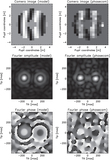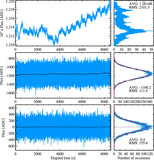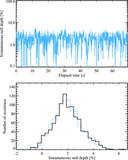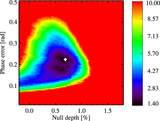Image Details

Caption: Figure 6.
Typical observing sequence used for the HOSTS survey. The sequence is divided in basic observing blocks (OB) consisting of one to two thousand frames, each having an integration time of typically 10–100 ms (depending on the brightness of the star). The complete sequence is composed of several successive OBs at null, i.e., with the beams from both apertures coherently overlapped in phase opposition, one OB of photometric measurements with the beams separated on the detector, and one OB of background measurements with the beams nodded off the detector. Each square represents a 256 × 256 subframe of the NOMIC detector that covers a region of approximately 4.″6 × 4.″6. The beams are aligned vertically in the middle of a given channel (see blue stars) to maximize the effective field of view and nodded back and forth by 2.″3 (up-down to preserve the differential pathlength). The dashed lines represent the limits of different detector channels. The right channels of the detector are not used directly for the null depth measurements but are useful for diagnostics and frame selection.
Copyright and Terms & Conditions
© 2016. The American Astronomical Society. All rights reserved.












